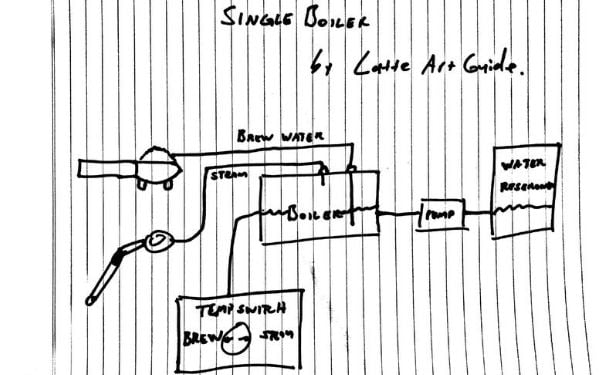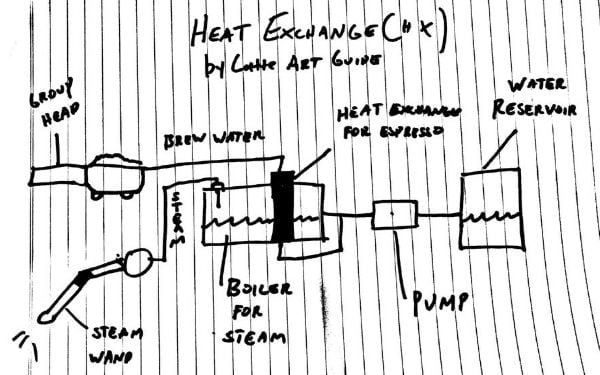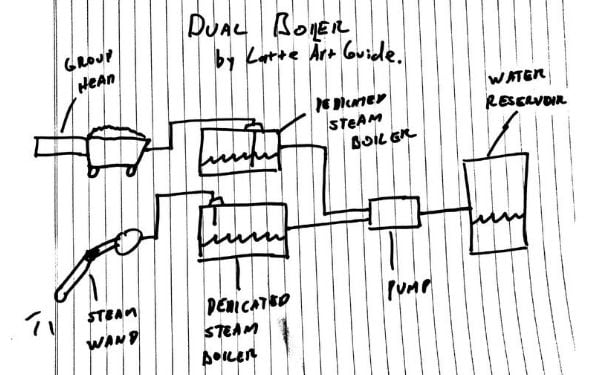If you're looking to buy an espresso machine you have may noticed that there are different types of coffee boilers to choose from: single, dual boiler, and heat exchange (HX).
But is the difference between these boilers? And is one boiler better than the other?
In this guide I'll be giving a barista's opinion on everything you need to know about coffee boilers.
What is a coffee boiler?
The coffee boiler is the engine of your coffee machine. It is coffee machine part responsible for creating the hot water to extract your espresso and steam to froth your milk. Without a good boiler you won't be able to make great tasting coffee.
Different types of boilers
There are three main types of boilers to choose from: single, heat exchange, and dual boiler. Below we outline their differences and their pros and cons.
Single boiler
A single boiler espresso machine uses a single boiler to both steam milk and produce the hot water to extract your espresso. This means you have to flip a switch on your espresso machine to change the boiler's temperature from steaming milk to exact espresso. This is because you need a higher water temperature to produce steam and a lower temperature to extract espresso.

This diagram shows how a single boiler coffee machine works.
You can see from the above diagram the single boiler is used to both brew and steam milk. The switch needs to be changed to adjust the temperature.
Pros
The main benefit of single boiler machines is that they are much cheaper. They are typically found in entry level espresso machines under $1,000.00. Heat exchange and dual boiler machines are more expensive as they have more machinery that adds to the cost of the machine.
Cons
The main con of single boiler machines is that you cannot steam milk and extract espresso at the same time. As you have to wait to wait for the machine to change temperature before being able to use the function.
Who does a single boiler suit best?
Single boiler coffee machines are ideal for people looking to get their first espresso machine who don't mind waiting to switch from steaming and extracting espresso.
They are also good for people who only make coffee for themselves and not a lot a large household. If you need to make multiple coffees at a time, you're better off getting a heat exchange or dual boiler that allow you to steam milk and extract coffee at the same time. Otherwise your guests or family will be waiting around to get their coffee!
Finally, if you're an espresso drinker that doesn't like milk based coffee, a single boiler is all you need. You will rarely make milk based drinks so you might as well save some cash with a single boiler machine.
Heat exchange (HX) boiler
Heat exchange coffee boilers are single boilers that allow you to steam milk and exact espresso at the same time. They do this by having a "heat exchanger" within the single boiler that heats up the water on the way to the group head to make it perfect for extracting espresso.

This diagram shows how a heat exchange coffee machine works.
You can see from the diagram above, there is a boiler and within it a black cylinder that is the heat exchanger. The single boiler draws water from the water reservoir and is used to produce the steam to steam milk.
The heat exchanger draws water from water reservoir that then passes through the single boiler to change the temperature of the water to make it ideal for extracting espresso.
Pros
The main benefit of a HX boiler is that they can steam milk and extract espresso at the same time. This at one point was only possible with dual boiler espresso machines.
Since there is only one boiler in the machine it helps keep the cost down, making heat exchange boilers great value for money. As they can they do both functions without the need of two boilers.
You should get a machine with a heat exchange boiler if you need to steam milk and extract coffee at the same time - e.g. making coffee for multiple people or if you drink a lot of coffee each day.
Another pro is that heat exchange boilers are smaller compared to dual boilers. So if you need to save kitchen space a HX is a good option.
Cons
The main con of heat exchange boilers is that can't do some of the functions of a boiler machine - mainly using a PID to set the temperature of the water that is used to extract the espresso. A heat exchange boilers have a pre-programmed temperature by the nature of their design.
Only a dual boiler espresso machine can adjust the temperature of the water used to extract the espresso. Being able to control the temperature of your water can help bring out different flavours out of certain coffee beans. If you don't want to experiment with this (which in my opinion is the majority of people) then you are not missing out on much.
Some people say that another con is that heat exchange coffee machines can have larger temperature swings in the extraction process compared to a dual boiler, however you can get a HX boiler with a PID system that allows for more stable temperature.
Is a heat exchange boiler right for you?
A heat exchange boiler is great for anyone that wants to be able to steam milk and extract espresso at the same time. These boilers are great value for money as they can do most of the functions of a dual boiler machine for much less money.
Dual boiler
Dual boiler machines have one boiler dedicated to producing steam to froth milk and another boiler dedicated to extracting espresso. They are the most expensive of the three options as they have two boilers.

A diagram showing how a dual boiler system operates.
You can see from the diagram above, that there is a two boiler system. Both boilers draw water via the pump from the water reservoir, and then are heated up to the correct temperature to either steam milk or extract espresso.
Pros
The first pro of dual boiler machines is that you can steam milk and extract espresso at the same time. But so can heat exchange boilers, so what's the difference here? The main difference is that because you have dedicated boilers for each function you get more steam power compared to a heat exchange, and it also allows you to control the temperature fo each boiler.
This temperature control ability is the second benefit of a dual boiler system. The vast majority of dual boiler machines come with a PID system that lets you set the temperature of both your brew and steam boilers. Being able to control the temperature of the brew boiler allows you to experiment with how different temperatures affect different coffee beans. This is what you call a coffee geek feature.
Cons
The main con of dual boilers is that they are much more expensive compared to single and heat exchange systems. This is simply because you are doubling up the hardware. Two boilers is more expensive than one.
Should you get a dual boiler espresso machine?
You should get a dual boiler if you want to be able to experiment with water temperature, have the ability to steam milk and extract espresso quickly, and have the power to make a lot of coffee quickly.
What is the best boiler for an espresso machine?
Now that we have gone through the three main types of boilers you should be able to pick the best type of boiler for your needs.
In our opinion, the best back for your buck boiler is a heat exchange (HX) system. This is because you can steam and extract like a dual boiler for a cheaper price. This type of boiler also satisfies the needs of most people.
Single boilers are good for entry level machines or for people that just drink espresso. Dual boilers are suited for coffee geeks and for people that need the extra power to smash out a lot of coffee quickly.
Conclusion
I hope this guide has been helpful in describing the main differences between coffee boilers. If you have any questions, please leave a comment below!

